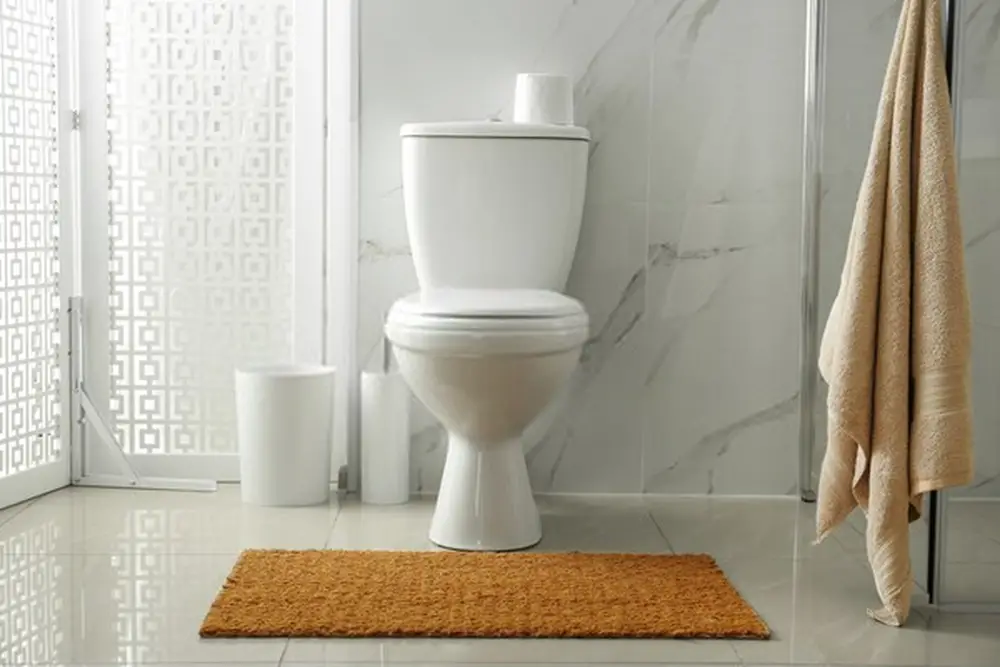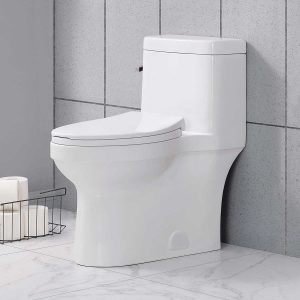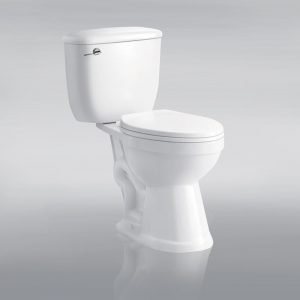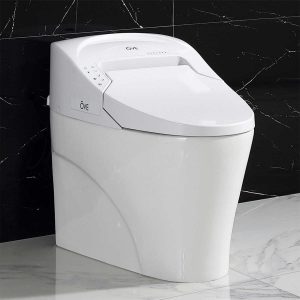How Much Does a Toilet Weigh? – [Comparing One Vs. Two Piece]

Toilets are heavy plumbing products, often requiring more than one person to lift. Toilets are built to last for years and you may spend a lifetime without having to lift or replace the toilet.
With that said, one-piece toilets weigh around 90 pounds, whereas two-piece toilets weigh closer to 55 pounds (Source).
However, different toilets are constructed differently, hence their weight varies from one model to another. For instance, the weight will depend on toilet configuration, design, and material. As such, the weight of a one-piece toilet is different from that of a two-piece toilet.
Throughout this guide, you will learn how different factors affect the weight of a toilet with examples of specific toilet models.
 One-piece toilets have the toilet bowl and tank fused together into a single unit that needs to be transported and installed together.
One-piece toilets have the toilet bowl and tank fused together into a single unit that needs to be transported and installed together.
As such, they are heavier than two-piece toilets. On average a simple one-piece toilet will weigh between 88 and 110 pounds.
For instance, the American Standard Champion 4 one-piece toilet weighs 119 pounds, while the Toto Ultramax II one-piece toilet weighs 99 pounds.
 These come in two main parts, the bowl and the tank. Each of the two components is lighter than a one-piece toilet.
These come in two main parts, the bowl and the tank. Each of the two components is lighter than a one-piece toilet.
Of the two parts, the toilet bowl is heavier than the tank. On average, the toilet bowl in a two-piece toilet weighs 50 to 60 pounds.
However, there are toilet bowls that are as light as 35 pounds. The weight of the tank in a two-piece toilet varies from one model to another. On average, it will weigh anywhere between 25 and 40 pounds, accounting for about 1/3 of the total toilet weight.
When combined, the tank and bowl in such a toilet will weigh about 80 pounds. A good example of a two-piece toilet is the Toto Drake two-piece toilet that weighs 87 pounds.
To learn more, read our comparison of one vs two-piece toilets.
As the name suggests, these toilets should be installed in a hanging position on a bathroom wall. To allow for the secure installation of the toilet, these units are produced lighter than traditional toilets.
Although their weight is determined by several aspects, an average wall-hung toilet weighs 55 to 75 pounds.
 Most smart toilets feature a compact design, with some lacking a tank.
Most smart toilets feature a compact design, with some lacking a tank.
Even so, these units can be really heavy. Some of them are even heavier than traditional one-piece and two-piece toilets.
This may be attributed to the many additional parts and features they have to offer, including heated seats, bidets, odor sprays, and water sprays. All this additional technology is bound to add something to the overall toilet weight.
Most of the leading Smart toilet models weigh between 90 and 120 pounds. For instance, the Kohler Veil Intelligent toilet weighs 110 pounds, while the Toto 700H can weigh as much as 123 pounds.
The various portable toilet models are meant to be lightweight and relatively easy to carry around. As such, they are the lightest of all toilet types discussed in this guide. On average, the best portable toilet models weigh between 10 and 15 pounds.
To make them this light, portable toilets are often made of plastic materials instead of porcelain as is the case with conventional toilets.
In addition to the toilet configuration and type, the weight of any toilet model depends on several other factors. Some of the main aspects that will determine how much a toilet weighs will be discussed here.
 Regardless of the make, model or even configuration, the weight of a toilet will mainly depend on the materials used to make it.
Regardless of the make, model or even configuration, the weight of a toilet will mainly depend on the materials used to make it.
The toilet basin and toilet base in most toilet models are made of porcelain, which is derived from clay.
The weight of this material mainly depends on the type of clay it is derived from. Another material commonly used to make toilets, especially by the leading toilet brands is Vitreous China. Other toilet parts are made of different materials, such as plastic, and steel.
Other toilet models come with birch hardwood or maple seats. All these materials are of different densities and the overall toilet weight will depend on how much of each material it has.
Toilets come in a myriad of sizes and designs, which tend to affect their weight to a certain extent. For instance, compact toilets meant for small bathrooms are smaller in size, hence lighter. Comfort-height toilets, on the other hand, are bigger in size.
The additional materials required to achieve the comfort height make these toilets heavier. Other toilet brands use smaller tanks on their toilets to make them lighter.
Different toilet brands use different processes to make their toilets. The process used by the manufacturer to produce a toilet is known to affect the weight of the toilet.
As such, you will find that a one-piece toilet model by one brand is heavier or lighter from a similar one-piece toilet by a different brand.
For instance, the Toto Ultramax II one-piece weighs 99 pounds, while the American Standard Champion 4 one-piece toilet weighs 119 pounds.
When installing or replacing a toilet, you will need to lift and even move the unit from one point to another.
As you have learned throughout this guide, most toilet models are quite heavy. If you are looking for a lighter toilet model, you should go for the compact toilet designs.
Better still, you can opt for a two-piece toilet, which is lighter and easier to carry from one point to another. If weight is not a concern, modern one-piece toilets will grace your bathroom with a sleek appeal.
Regardless of the weight of your preferred toilet model, you should have someone help you with the lifting and carrying. This makes the work easier and prevents damage to the new toilet.